
The Adonis blue is a butterfly in the family Lycaenidae. It inhabits the Palearctic realm.
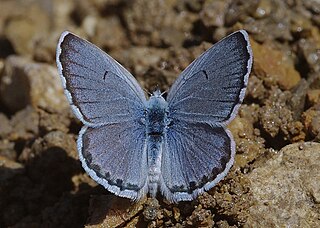
Pseudophilotes vicrama, the eastern baton blue, is a small butterfly found in Asia, east to Tian Shan and parts of China, west to the Balkans, Turkey, eastern Europe to southern Finland. It belongs to the lycaenids or blues family. The species was first described by Frederic Moore in 1865.

Polyommatus eros, the Eros blue or common meadow blue, is a species of blue butterfly found in the Palearctic.
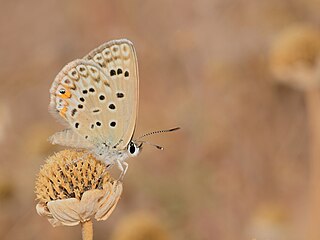
Plebejidea loewii, the large jewel blue, is a species of blue (Lycaenidae) butterfly.

Kretania hesperica, the Spanish zephyr blue, is a species of butterfly in the family Lycaenidae. It is endemic to Spain. Its natural habitats are temperate shrubland and temperate grassland. It is threatened by habitat loss. Seitz describes it thus - hesperica Rbr. is above sky-blue instead of violet-blue; from Spain.

Kretania is a Palearctic genus of butterflies in the family Lycaenidae.

Lasiommata maera, the large wall brown, is a butterfly in the family Nymphalidae.

Glaucopsyche alexis, the green-underside blue, is a butterfly of the family Lycaenidae. It is found in the Palearctic.

Polyommatus daphnis, the Meleager's blue, is a butterfly of the family Lycaenidae.
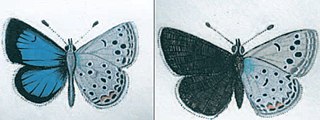
Turanana endymion, the odd-spot blue or Anatolian odd-spot blue, is a butterfly of the family Lycaenidae. It was described by Christian Friedrich Freyer in 1850. It is found in Turkey, Lebanon and Iran. Records from Europe refer to Turanana taygetica.
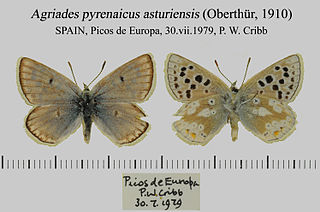
Agriades pyrenaicus, the Gavarnie blue, is a Palearctic butterfly of the family Lycaenidae. It is found in the Asturias mountains of north-western Spain, the Pyrenees, the southern Balkan Peninsula, Turkey, the Caucasus and Armenia. The habitat consists of alpine grassy rocky meadows where it is found at altitudes ranging from 1,500 to 2,200 meters.
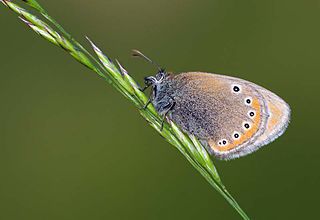
Coenonympha leander, the Russian heath, is a butterfly belonging to the family Nymphalidae. It is found in northern Greece, Hungary, Bulgaria, southern Russia, Asia Minor, Armenia and Iran. The habitat consists of warm grassy areas.

Lysandra corydonius, the false chalkhill blue, is a butterfly of the family Lycaenidae. The species is distributed in south-eastern Europe, Caucasus, Transcaucasia, north-eastern Turkey, and north-western Iran. L.corydonius is very similar to Lysandra coridon but a slight violet sheen is present, especially in the outer area of the wings. It inhabits a wide variety of grasslands and woodlands. In Armenia it occurs from 1200 to 2000 m above sea level. The known larval host plants of the species in Turkey is Hippocrepis comosa, in the Caucasus - Coronilla varia. The species has not been assessed for the IUCN Red List. In Armenia from 2003 to 2013 its population increased.
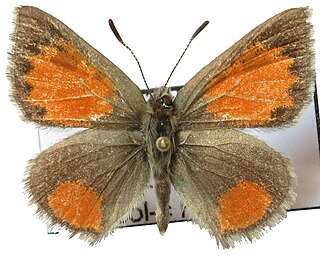
Tomares callimachus, the Caucasian vernal copper, is a butterfly of the family Lycaenidae. It is found in Anatolia, Iraq, Iran, the Caucasus, and Transcaucasia.

Lycaena candens is a small butterfly found in the Palearctic that belongs to the lycaenids or blues family.

Tomares nogelii is a small butterfly found in the Palearctic that belongs to the blues family.

Kretania eurypilus, the eastern brown argus, is a butterfly found in the East Palearctic that belongs to the family Lycaenidae.
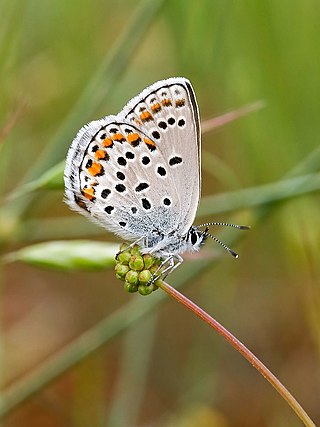
Kretania sephirus, previously known as Plebejus sephirus, is a species of butterfly that belongs to the family Lycaenidae. It is found in Eastern Europe, the Caucasus, and Asia Minor. The species is part of a species complex, with many members of the complex using variations of the name zephyr blue, including pylaon, trappi, and hesperica. The species, which previously belonged to the genus Plebejus, was moved to the genus Kretania following a 2013 molecular phylogenetics study of the subtribe Polyommatina. Many sephirus populations are threatened, and are legally protected in some countries, such as Hungary.

Kretania zephyrinus is a butterfly found in the East Palearctic that belongs to the blues family.




















